
|

|
LINKS FOR THE YEAR 2003 |
| [JAN] [FEB] [MARCH] [APRIL] [MAY] [JUNE] [JULY] [AUG] [SEPT] [OCT] [NOV] [DEC] |
Archives [Intro] [2000] [2001] [2002] |
|
Log for the week of March 2, 2003 Cape Town by PS Sorry for the late posting of Amy's log. We have left the convenience of the small town for the challenges of the big city. In Mossel Bay, we were a 5 minute walk from everything. At the Royal Cape Yacht Club we are a 30 minute walk from most everything and not a very safe walk at that. Monday morning our friends from Red Oranda were waiting to take our lines. It's sure nice to get directions into a berth. We called port control repeatedly without success. Seems they don't monitor VHF 16. About 100 meters before the entrance, Cape Town Radio told us to try 14. We finally got Port Control and they said we could enter. In ports with heavy shipping traffic, it's prudent to let people know what your intentions are. It was Red Oranda that gave us directions to find the Yacht Club. "Just head for the orange oil drilling rig." Let me tell you, an unballested oil rig can't be mistaken for anything else. We tied up and settled the boat down, all the while Table Mountain dominating the view. We headed to the Yacht Club to get checked in, get our long awaited mail and find out about seeing immigration. The mail was being held ransom for R18 ($2US). We gladly forked over the money and barely made it back to the boat before diving into the chocolates Amys parents shipped from South Carolina. We are true chocoholics! At 5pm we checked in with Fred on the Peri Peri Net. We had SMSed from the cell phone (all 8US cents worth) upon our arrival, but were concerned about the Spanish single hander Isi. He had yet to arrive and had left Mossel Bay before we did. Calls were made to various yachts in different ports, but there was no sign of him. I was afraid to look on the bow anchors of the ships in the harbor, for fear he had become a victim of collision. If I ever saw sailboat rigging dangling off a ship, I would probably quit passage making. No sooner had we finished on the radio, when a knock came on our hull. It was Isi, safe and sound. He was so glad for our help in Mossel Bay, that he insisted on taking us out on the town the following day, which we readily accepted. Tuesday the three of us headed to the Victoria and Alfred waterfront. We stopped at immigration after much back-tracking and inquiries along the way. It was not easy to find, even after getting directions from the yacht club. No signs led the way or identified the building. I hate looking lost. The road stragglers easily identify a "mark" who stops on the street, stares at a piece of paper (which is held in various positions) and then looks at the surrounding buildings. There were three of us, so I thought we could hold our own, or at least I had hoped we could. This overhanging cloud did not exist in Mossel Bay.
We rented a car in the afternoon and drove around trying to find an Internet cafe where we could update the log. After several stops, we ended up at the Catwalk.tv Internet cafe at Sea Point, about 5 kilometers from the Yacht Club. Good thing we had a car. They were the first ones that would let us put our ftp program onto their network. For R10 ($1.25US) an hour, we had a very fast broadband connection. The only problem was, I had forgotten the ftp program installer CD. Doh! Sometimes this "Cruiseheimers" really gets on my nerves. We went down to Hout Bay later that afternoon, where most of the boats heading north are berthed. We drove along the ocean front, past fancy hotels and villas set into the steep coastline. Hout Bay was pretty quiet when we arrived around 5pm. There were a few trawlers unloading there catch and some waterside restaurants serving dinner. The town was about a kilometer from the waterfront, so shopping wasn't very convenient. Also, it is a very windy port. When it blows 35 knots in Cape Town, it blows 55 knots in Hout Bay. Not somewhere I would be comfortable leaving a boat for any length of time. If we had to sail around South Africa again, we would go to Richards Bay, to be close to the Game Parks and then spend the rest of our time in Mossel Bay. Thursday morning we tackled the log update. I say tackled because the person behind the counter at the Catwalk.tv cafe didn't know how to install the ftp program. She thought I could just put it on the computer I was using. No such luck. It needed to be installed on the host computer. Agg. I noticed an ftp program on the terminal I was using, so I gave it a try. "Smart ftp" is not very intuitive, but after several attempts, I got the hang of it. The learning curve is never ending.
Friday, we visited the Kirstenbosch Botanical Garden. Set at the foot of Table Mountain, it covers 80 hectares of sloping ground. Amy had wanted to visit this world famous garden since she was twelve. We spent the better part of the day hiking up and down the garden paths, learning the names of the varity of native plant life. It made us more homesick than ever. The smell of wet earth, digging your hands into the warm soil and picking a ripe tomato and popping it into your mouth. All distant memories of another life, but one we will soon be returning to. 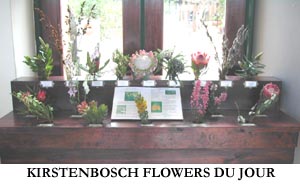
Well, I say soon. I have laid out the route to Maine and we have 7331 nautical miles to go. There are no land masses in our way, no more great capes to conquer, no more heading south, away from Maine. If we had unlimited fuel, we could be home in about 2 months, motoring 24 hours a day 7 days a week. Ah but such is not the case. The trade winds are fickle. There is a large cyclone hitting the Mozambique coast. Amy claims that if there is a cyclone within 1,000 miles, the weather patterns are all messed up. I think she is correct, because the Atlantic high is spread out and only 1018mb. Do we wait for the trades to return, or start motoring our way home? With a 1,000 mile motoring range on Iwalani I think you know the answer. PS Log for the week of March 9,2003 29 37s 12 05e enroute to St Helena by APW It all started with a knock on the hull. "I'm Gaynor." the tall classically sculpted women said. "We have been looking for a boat that's not a plastic fantastic to use in a photoshoot for bathing suits." It didn't take long for Phil and I to defer our leaving South Africa for a few hours in order to accomodate Cosmopoilitan magazine, especially when I found out how much we would get paid. The following morning eight people showed up-one Swedish model, the photographer and six assistants. We sailed around in a light breeze while the model struck assorted poses in the rigging-in various stages of dress, or undress as it were. I never knew that Barbie dolls actually had a human prototype. This was my first experience with a lingerie supermodel and I can honestly say they probably think celulite is a low cost cell phone plan. In addition to being a platform for scantily clad beautiful women, Iwalani is carrying 150 lbs of truck parts for the government bus in St Helena. Hopefully this will give us an "in" when we arrive-as the officials have exorbitant fees for visiting yachts. Fair winds so far-Southerly 15 knots and a record run of 170nm. Full stores of good Capetown food and books which we will eat up in no time. APW Log for the week of March 16,2003 20 54s00 12e 400nm to St Helena by PS 6,054nm to Maine. Our record 170nm noon to noon run shortly after leaving Cape Town was a false promise. Ten days to St Helena? No such luck. I was reminded once again why I hate passages, especially in the southern oceans. Shortly after leaving Cape Town a strong low formed to our south, sending a 12ft swell from the SW hittng us broad side. Between the 8ft swell from the SE on our stern (where the wind was coming from) and the 12ft swell from the SW we were in "Washing machine mode. "I don't mind the "Knit/delicate" cycle or even "Cotton" but the "Extra Heavy Duty" cycle is a bit much. Life is reduced to trying to keep upright when moving around and wedging youself into your bunk to rest. I can hear you saying "What a whiner."I say "This is REAL TV. "After a week of "Hanging on" we finally have weather where you can make a cup of instant coffee on the first try. SE winds at 15knts and 3ft seas. Our cargo of government bus parts is still on deck, so we hope to at least get a tour of the island for our good stowing job. PS Log for the week of March 23, 2003 St Helena South Atlantic by APW On the morning of the thirteenth day at sea I thought I could see the tall peaks of St. Helena rising in the Northwest, eighty miles away. "You're crazy"Phil kept saying to me,"There's nothing there."There was haze in front of us, obscuring the horizon. Perhaps I was seeing things, but back when I was a kid cruising with my Dad, before yachts were equipped with GPS and radar, we used dead reckoning and a wild imagination to pick out subtle differences of gray indicating islands enveloped in fog. As the day wore on, even I began to lose the shape of the island in the thickening clouds to the northwest. Still, the radar and our GPS showed we were right on course. Before it got dark we scandalized the main in order to jibe the boom. In twenty plus knots of wind I have come to dread the process. Lately we seem to be unable to perform a smooth jibe without Murphy getting involved in one way or another. As long as we are not tired it goes uneventfully. But usually we jibe at the end of one of our watches, in which case one of us is usually half asleep. Fortunately this time everything went smoothly. It seems to be the short passages that make us the most tired and invite the largest accumulation of Murphy points. At midnight, I was tired and went down below for a nap. We were about eight miles away and long before I became glued to my pillow from the drool that seems to escape a mouth that is constantly being rubbed back and forth in a moving bed, I was awoken by Phil pounding on the hatch. He never pounds on the hatch. It was like a flamethrower had lit all four of my burners simultaneously, accomplishing in seconds what three cups of coffee can seldom do. I put my harness on and went out on deck. When I had gone below for my nap, a full moon was shining, providing enough light to see colors. The boat was moving along a few adjectives above gently in fifteen knots of wind. Everything was well with the world. Now, we were in an eerily lit cloud with horizontal rain and twice as much wind. Off the port side I saw a black band a half-mile away, presumably St. Helena, the higher elevations covered in rain. Within a few seconds, even that disappeared. Phil had already scandalized the main and was trying to put in a reef. "Lets just take it down."I yelled to him, over the sound of the wind, the waves, the rain and the wind generator, making enough electricity for Milwaukee. Even with both downhauls, getting the sail down was hard to do as the wind had pinned the sail against the shrouds. "Welcome to St. Helena!" Phil screamed into the rain, wearing only his harness and nothing else. Eventually we surfed our way around the island and once in the lee, anchored, took hot showers and went to bed. Such is the cruising life.
The yachts that visit here usually stay only a few days, before the constant rolling drives them back to sea, where at least they can be making headway while spilling cups of coffee. The radio nets warned of exorbitant fees. In addition to the landing fee, we were charged a yacht fee- (10 lbs) and a health insurance fee- supposedly 10 lbs per person per day. We've been trying to get that waived as we have health insurance, but as I write, this hasn't come to pass. It appears that the hospital may not recognize this health insurance either, so this needs to be investigated before we depart. There is a St. Helena "mail" ship, which travels between England, South Africa and Ascension, seven hundred miles to the North- which does have an airport and regular flights to the US. The ship brings cars, onions, fruit, eggs, everything really. It is the main IV line to the world. Television arrived in St. Helena in 1995- it is interesting to see how it will effect crime, which up until this point was non-existent. A group from Saudi Arabia is trying to build an airport and hotel, plus a new golf course (in addition to the one already here). Locals seem leery of it.
After clearing in, (a process that was made even more difficult by the fact that the customs office was rising and falling on some sort of subterranean swell- I could have signed our lives away without realizing it, under the full affects of land sickness,) we headed off to explore the town. The Portuguese discovered St. Helena in 1502. They kept it a secret, in order to use it for re-provisioning. Eventually it was discovered by the British and later the Dutch, both of whom wrestled back and forth for control over it for the next two hundred years.
We
eventually found the owner of the spare truck parts that we
transported from Cape town. A mild mannered Saint, Collin Williams
had no problem honoring our request for a tour of the island as our
shipping fee. We arranged it for Saturday morning. In the mean time
we needed exercise. We could walk the seven hundred steps up Jacob's
ladder, something you couldn't pay me to do in my swaying, swerving,
land sick state, so we headed up through town and were eventually
offered a ride in the back of a pick-up truck. We were deposited at
the Plantation house. We walked along the road, passed the new school, a more practical gift from Prince Andrew, and eventually found the path that took us back to town. Two weeks of sea makes dramatic views of green hills, orchids and ferns growing along the side of the road, the smell of hot dirt, the hum of insects, the song of the turtledove, the cries of mynah birds, even the grumbling of a stomach, all the more enjoyable. On
Saturday we had our tour. We also
noticed that there were lots of older people on the island, but not
so many teenagers. We ended
up on the southwest corner of the island in a place called Sandy bay.
Oddly, the higher elevations of the island have dense trees and many
flowers. Some slopes are covered with flax, which used to be the main
export on the island. But since Iwalani is almost the only boat left
in the world that uses flax packing in it's stuffing box, the
industry has gone the way of copra plantations, nutria farms and 8
track tapes. There used to be a Veterinarian on the island, but no longer. Between Phil starting up the wind farm and me working as a Vet, there would be more than enough work to do. Or for that matter anyone interested in reviving the flax industry, or growing bananas, in the only place in the world completely free of banana blight. There are plenty of beautiful empty plantation houses with rolling fields and beautiful views, all very inexpensive, to fix up and live in. As tempting as it is, and as much as we enjoy islands, the fact that St Helena is second only to Antarctica in terms of inaccessibility, made us return to Iwalani to work on the boat projects that would take us closer to home. We bought a little more diesel, (exactly the same price as Great Britain-76p a liter), sewed another patch on the jib, which is slowly becoming more patch than original sail, cleaned and restocked. Phil wandered around "looking for trouble" as he calls it. Finding none, he decided to take the autopilot arm apart and re-grease it. As a reward for finishing these necessary evils, we decided to launch the dinghy and explore the underwater world of St Helena. Customs had asked us not to use our SCUBA tanks, while here, which it turns out, weren't even necessary as the clarity of the water was such we could see each dimple on each stone twenty feet below us. Once we were in the water, fish from all over, swam to be with us. It was almost like they had never seen a person before and were as curious about us as we were about them. Phil likened the underwater terrain to walking in a deep wet woods, with lichen covered moss and rocks. Small bits of coral grew on some of the rocks, but this wasn't really a coral reef. It was very different from a coral reef- and yet equally as nice, because of the phenomenal colors of the fish and the clarity of the water. Butterfly fish, a soft lilac color edged in gold swam about us like falling petals from a magnolia tree. Surprisingly, there were many other tropical fish-parrot fish, angelfish, triggerfish, wrasses in every color and one six inch sergeant major that spent the entire time swimming next to us, head cocked to one side for a better view. After we find some duct tape and post this log we're heading North. APW Log for the week of March 30,2003 11 26s 15 01w enroute to Fernando de Noronha, Brazil by PS via Inmarsat-C 5,017 miles to Maine Well it's hard to believe, but we are in idyllic weather. Fair winds of 10 knots and calm seas for a week straight. We haven't trimmed the sails or changed the auto-pilot once. I'm not sure if this is a reward for past sufferings or there is payment still to be made. While our daily runs have averaged only about 100 miles, I'm not complaining. We are heading for home and getting to relax. We are just now finishing the 63 bananas Collin gave us. Banana cream pie, banana cupcakes, banana bread, banana chips, fried bananas. And to think I swore them off when I regurgitated them into the North Atlantic at the start of our trip. I've managed to finish a 1,000 page book on computer networking and am wading through Churchills "The Second World War", all 972 pages (This is the abridged edition!) PS |
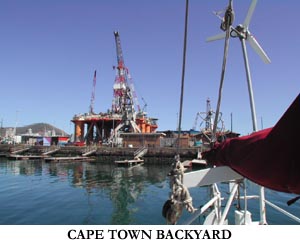
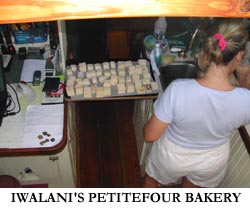 Twenty minutes later we arrived at the restored V&A waterfront, surrounded by tourists and in the relative safety of busy mall surroundings. It was fun getting to know Isi better and we were eventually joined by Paloma's crew. Isi has always been the adventurer. Some of his exploits in small planes were hair-raising indeed. The captain of Paloma was a model maker from Germany, building prototypes for manufacturers. He designed his own hull and had it built, then finished off the deck and interior himself. We returned to the yacht club by taxi.
Twenty minutes later we arrived at the restored V&A waterfront, surrounded by tourists and in the relative safety of busy mall surroundings. It was fun getting to know Isi better and we were eventually joined by Paloma's crew. Isi has always been the adventurer. Some of his exploits in small planes were hair-raising indeed. The captain of Paloma was a model maker from Germany, building prototypes for manufacturers. He designed his own hull and had it built, then finished off the deck and interior himself. We returned to the yacht club by taxi.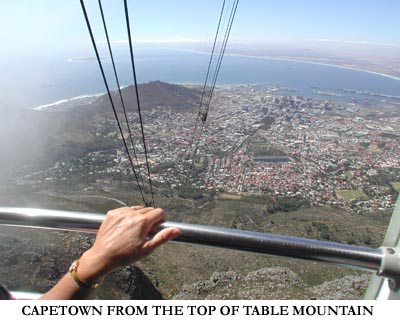 Next we headed for the Table Mountain cable car. We wanted to scope out the possibility of hiking up and taking the cable car down. We discovered you could do it, but had only two choices. You could hike up from the backside of the mountain, take the cable car down then hire a taxi to take you back to your car or hike up the steep path directly under the cable car. We opted for choice number three. Take the cable car up and back. I had checked the weather the previous day to make sure the mountaintop would be clear. The local conditions say that if the mountain has a tablecloth the winds will be strong. The forecast was for calm winds and conditions were ideal. What a view. We could see Hout Bay, False Cape, Cape Point and 50 miles in every direction.
Next we headed for the Table Mountain cable car. We wanted to scope out the possibility of hiking up and taking the cable car down. We discovered you could do it, but had only two choices. You could hike up from the backside of the mountain, take the cable car down then hire a taxi to take you back to your car or hike up the steep path directly under the cable car. We opted for choice number three. Take the cable car up and back. I had checked the weather the previous day to make sure the mountaintop would be clear. The local conditions say that if the mountain has a tablecloth the winds will be strong. The forecast was for calm winds and conditions were ideal. What a view. We could see Hout Bay, False Cape, Cape Point and 50 miles in every direction. 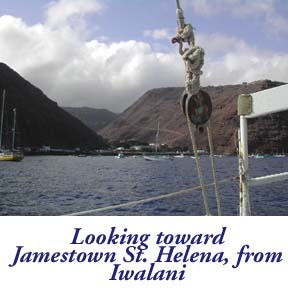 When we awoke our country was at war with Iraq, but
we were anchored in probably the safest possible place on the entire
planet. There are roughly five thousand St. Helenians, or "Saints" as
they call themselves. The island is part of Great Britain and the
governor, (not elected by the Saints), is given the post at St.
Helena as a reward, usually just before retirement. Other British
islands-(The Falklands, Virgins, even Ascension), involve too much
work. There is no airport at St. Helena. The are no planes, no trains
and no real anchorage. There is no breakwater, a bone of contention
and potential source of revenue. An outboard "ferry" boat takes
people from their yacht or fishing boat, to "shore." The landing spot
is a cement pier that the ferry comes along side. Ropes hang down
from a steel bar, and as the launch rises and falls from the swell,
one either steps gracefully to land, or swings from the rope like a
drunken Tarzan. Sometimes the swell is too much and no one can land.
If no one lands, the island can't collect landing fees- roughly 11
lbs per head. The QE2 comes here- but if there is too much swell and
with no breakwater- no one can go to shore. Cruise ships have come
and gone without spending a dime.
When we awoke our country was at war with Iraq, but
we were anchored in probably the safest possible place on the entire
planet. There are roughly five thousand St. Helenians, or "Saints" as
they call themselves. The island is part of Great Britain and the
governor, (not elected by the Saints), is given the post at St.
Helena as a reward, usually just before retirement. Other British
islands-(The Falklands, Virgins, even Ascension), involve too much
work. There is no airport at St. Helena. The are no planes, no trains
and no real anchorage. There is no breakwater, a bone of contention
and potential source of revenue. An outboard "ferry" boat takes
people from their yacht or fishing boat, to "shore." The landing spot
is a cement pier that the ferry comes along side. Ropes hang down
from a steel bar, and as the launch rises and falls from the swell,
one either steps gracefully to land, or swings from the rope like a
drunken Tarzan. Sometimes the swell is too much and no one can land.
If no one lands, the island can't collect landing fees- roughly 11
lbs per head. The QE2 comes here- but if there is too much swell and
with no breakwater- no one can go to shore. Cruise ships have come
and gone without spending a dime.  From the water, St. Helena has to be about the ugliest island
on the planet. Large blobs of dark brown treeless lumps rise stolidly
from the middle of the Southern Atlantic, like a three year olds
version of a mud pie island. Slab sided walls of brown earth slough
chunks of dirt and rock hundreds of feet to the ocean below. An
occasional waterfall of green, high overhead, gives some hint of the
lush interior, as plants cascade over the brown cliffs, like pea soup
spilling from an overfull bowl. The surrounding Atlantic is the
clearest ocean water I have ever seen. In some spots along the shore
it is a color called phthalocyanine blue. I mistakenly bought a tube
of this paint years ago and it has sat unused in my paint box, as up
until this point, I thought this color didn't exist in nature. There
are no beaches- no stretches of clean white sand. On the southwest
corner there is a small "beach", more of a gravel pit than
recreational spot. But, like some of the ugliest fruit on the
planet-
pamplemousse and figs, to name just a few, the real treasure is in
the interior.
From the water, St. Helena has to be about the ugliest island
on the planet. Large blobs of dark brown treeless lumps rise stolidly
from the middle of the Southern Atlantic, like a three year olds
version of a mud pie island. Slab sided walls of brown earth slough
chunks of dirt and rock hundreds of feet to the ocean below. An
occasional waterfall of green, high overhead, gives some hint of the
lush interior, as plants cascade over the brown cliffs, like pea soup
spilling from an overfull bowl. The surrounding Atlantic is the
clearest ocean water I have ever seen. In some spots along the shore
it is a color called phthalocyanine blue. I mistakenly bought a tube
of this paint years ago and it has sat unused in my paint box, as up
until this point, I thought this color didn't exist in nature. There
are no beaches- no stretches of clean white sand. On the southwest
corner there is a small "beach", more of a gravel pit than
recreational spot. But, like some of the ugliest fruit on the
planet-
pamplemousse and figs, to name just a few, the real treasure is in
the interior. 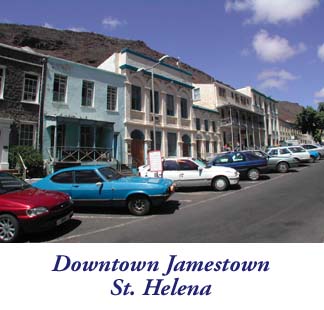 Jamestown, the main village, is
nestled in a valley on the lee side of the island. The British
eventually built a castle along the shore, complete with moat, in
order to keep the Dutch out. Pretty stucco buildings and mature shade
trees have replaced the stream that carved the gully between the
brown hills. Because of its isolation, St. Helena became the final
resting place for many prisoners of war- several thousand Boers, one
Zulu king and the most famous- Napoleon.
Jamestown, the main village, is
nestled in a valley on the lee side of the island. The British
eventually built a castle along the shore, complete with moat, in
order to keep the Dutch out. Pretty stucco buildings and mature shade
trees have replaced the stream that carved the gully between the
brown hills. Because of its isolation, St. Helena became the final
resting place for many prisoners of war- several thousand Boers, one
Zulu king and the most famous- Napoleon.
 Our driver, a one time Canadian, told us about a
great hike back to town along the Barnes road. First we wandered over
to the Plantation house, hoping for a cool drink on the veranda and a
light summer salad for lunch. I had packed water with us, but the
stashes of peanuts I usually keep in my backpack were handed out to
street people in South Africa. We were starting to get hungry.
Plantation house, as it turned out was not an inviting hostelry, but
the home of the governor. It fooled us because there were no security
fences, razor wire, armed guards or signs shooing us away. One sign
encouraged us to be careful when photographing the giant tortoises on
the lawn, as they could reach high speeds when they wanted to. Huh?
We wandered down the driveway and found a gate onto the front lawn
where we watched the giant tortoises- a gift from the Governor of the
Seychelles over a hundred years ago- slowly chewing grass like aged
old men gumming asparagus. After marveling at the after effects of a
high fiber diet on a tortoise that weighs several hundred pounds, we
decided that giving a tortoise as a gift has even greater
ramifications to the inheritors than a gift of a parrot, whose life
span is only a fraction of that of a tortoise.
Our driver, a one time Canadian, told us about a
great hike back to town along the Barnes road. First we wandered over
to the Plantation house, hoping for a cool drink on the veranda and a
light summer salad for lunch. I had packed water with us, but the
stashes of peanuts I usually keep in my backpack were handed out to
street people in South Africa. We were starting to get hungry.
Plantation house, as it turned out was not an inviting hostelry, but
the home of the governor. It fooled us because there were no security
fences, razor wire, armed guards or signs shooing us away. One sign
encouraged us to be careful when photographing the giant tortoises on
the lawn, as they could reach high speeds when they wanted to. Huh?
We wandered down the driveway and found a gate onto the front lawn
where we watched the giant tortoises- a gift from the Governor of the
Seychelles over a hundred years ago- slowly chewing grass like aged
old men gumming asparagus. After marveling at the after effects of a
high fiber diet on a tortoise that weighs several hundred pounds, we
decided that giving a tortoise as a gift has even greater
ramifications to the inheritors than a gift of a parrot, whose life
span is only a fraction of that of a tortoise.
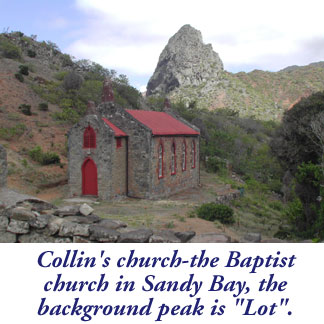 Collin took us down every road on the
island and filled us in on local facts not divulged by any tour
guides. The island is divided into four regions-each with their own
elected councilor. He told us that each region has their own unique
accent- and it's hard even for him to understand some of the people
from the other side of the island. Mind you, this island is only four
miles wide and eight miles long. He said years ago the island got
more rain, there were more fruit trees and people were more self
sufficient. We passed by a wind farm- three large wind generators
standing idle, with twenty knot trade winds whistling through their
stationary blades. They were bought from a company that went
bankrupt, by some official in England. The parts that are needed to
make them work, are no longer available.
Collin took us down every road on the
island and filled us in on local facts not divulged by any tour
guides. The island is divided into four regions-each with their own
elected councilor. He told us that each region has their own unique
accent- and it's hard even for him to understand some of the people
from the other side of the island. Mind you, this island is only four
miles wide and eight miles long. He said years ago the island got
more rain, there were more fruit trees and people were more self
sufficient. We passed by a wind farm- three large wind generators
standing idle, with twenty knot trade winds whistling through their
stationary blades. They were bought from a company that went
bankrupt, by some official in England. The parts that are needed to
make them work, are no longer available.
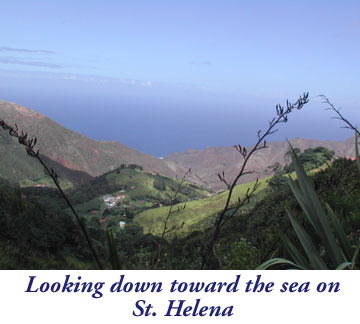 He said that about a year ago, Britain finally allowed St.
Helenians the same rights as the United Kingdom people. Before, they
couldn't have British passports. A thousand young people left in
search of higher education and something "better".
He said that about a year ago, Britain finally allowed St.
Helenians the same rights as the United Kingdom people. Before, they
couldn't have British passports. A thousand young people left in
search of higher education and something "better". 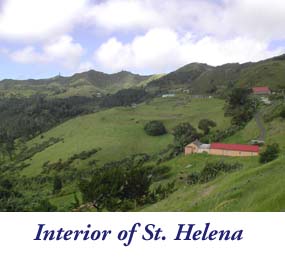 Which is too
bad, as flax used to be used in rope making and as soles on
espadrille shoes. The base of the hills and lower elevations look a
little like Mars- rocks and dirt and nothing else. It takes a little
getting used to upside down mountain colors. After a stop at Collin's
house for tea, we left with an entire tree of bananas.
Which is too
bad, as flax used to be used in rope making and as soles on
espadrille shoes. The base of the hills and lower elevations look a
little like Mars- rocks and dirt and nothing else. It takes a little
getting used to upside down mountain colors. After a stop at Collin's
house for tea, we left with an entire tree of bananas.